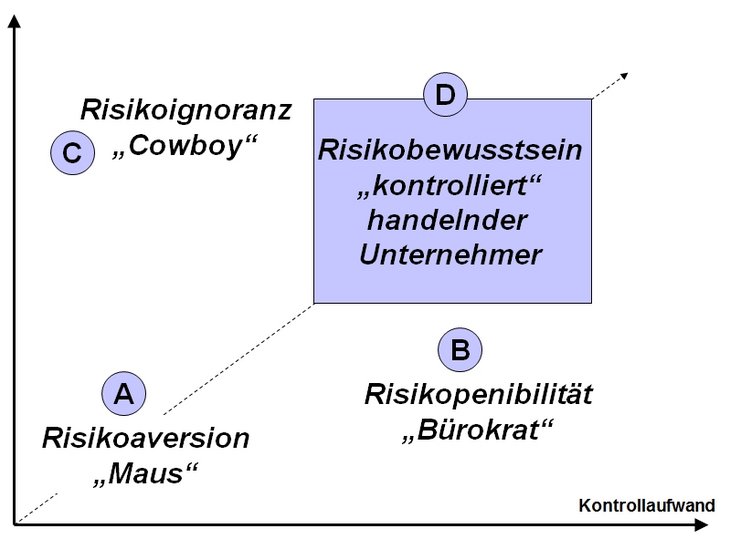Risk is a construct. Risks are a construct of our perceptions: Our knowledge, our emotions, our moral convictions, fashions, judgements and opinions determine the risk construct [see Romeike/Müller-Reichart 2008, p. 53 onwards, and Romeike 2013].
What one person perceives as a risk may be a long way from being a risk for another. Risk perception is also based on hypotheses. This means that different assumptions and theories are frequently developed for the same risks. The discussion about risks in genetic technology is an example of the subjectivity of (societal) risk perception. On the one hand, resistance can be observed as a protest against the dominance of innovation processes and based on fundamental ethical objections. On the other hand, opportunities can be "perceived" in plant breeding, livestock breeding, the food industry and medicine. Perception is determined by a context, which means taking account of the geographical and time perspective. There is no perception without a context.
Financial and currency crises very often provide evidence that people have no natural instinct for risks. The anchoring effect from cognitive psychology provides a reason for this [see Kahneman 2011, p. 119 onwards]. Environmental information has a major influence on assessment (of risks) even if they are actually irrelevant for the decision. We attach ourselves to an arbitrary "anchor": Risk becomes a construct of our perceptions.
In addition, people lack an intuitive understanding of probabilities. For example, we often make investment decisions based solely on expected returns. We ignore the fact that expected returns can only be assessed in the context of the associated risks. Academics call this "neglect of probability" [see Rottenstreich/Hsee 2001, and Kahneman 2011, p. 143 onwards]. In practice, this leads to poor decisions and frequently also to micro or macro economic crises.
Black swans
Taleb [see Taleb 2008] has been particularly critical of the fundamental value of methods and models in risk management. He refers to the exceptional significance of very rare and almost unforeseeable individual events. These exceptional individual events, which he calls "black swans" are "outliers" that lie outside the normal range of expectation as nothing comparable has happened in the past.
In risk management people systematically underestimate the consequences of extreme events, which are frequently a threat to existence. We think in coherent stories, link facts to form a coherent picture and take the past as a model for the future. We thus create a world in which we feel comfortable. But the reality is different – it is chaotic, surprising and incalculable. Taleb believes that most people ignore "black swans" because it is more pleasant for us to view the world as ordered and comprehensible. Taleb calls this blindness "platonic fallacy" and postulates that this leads to three distortions [see Romeike 2009]:
- Narrative fallacy: Subsequently creating a narrative to assign an event an identifiable cause.
- Ludic fallacy: The belief that structured randomness, as occurs in games, is the same as unstructured randomness in life. Taleb criticises models in modern probability theory such as the Random Walk.
- Statistical regress fallacy: The belief that the nature of a random distribution can be determined from a series of measurements.
Heterogeneous risk typologies
Efficient management and monitoring of risks and identification and exploitation of opportunities is a core entrepreneurial activity. Nevertheless, companies' willingness to take risks differs hugely, partly depending on the managers' or owners' risk propensity. The figure below shows an ideal typical categorisation of risk types.
A "mouse" (A) takes low risk and has an extremely low management requirement. By contrast, the "bureaucrat" (C) is similarly risk averse but thanks to his control structure accepts that his opportunities – and therefore his growth and development potential – is extremely limited. A "cowboy" (C), on the other hand, risks the danger of being surprised by negative developments that he is unable to control. The "controlled entrepreneur" (D) uses the tools of risk management in his decisions and takes risks in a conscious and controlled manner in order to take advantage of the associated profit opportunities.
Experts and laymen wear different "risk goggles" and see and evaluate risk differently, even when they are looking at the same thing. Laymen weigh up risks purely subjectively (knowledge, emotions, culture etc.) and ask themselves questions such as: "Do I feel threatened?" or "Am I afraid?". In addition, risk perception and evaluation has to take account of cultural differences.
Further literature:
- Gleißner, W./Romeike, F. (2012): Psychologische Aspekte im Risikomanagement - Bauchmenschen, Herzmenschen und Kopfmenschen [Psychological Aspects of Risk Management - Gut People, Heart People and Head People], in: Risk, Compliance & Audit (RC&A), 06/2012, S. 43-46.
- Kahneman, D. (2011): Thinking Fast and Slow, Penguin Books, Allen Lane 2011.
- Romeike, F. (2009): Die 3 "M": Aktuelle Herausforderungen für das Risikomanagement von Versicherungsunternehmen [The "3Ms": Current Challenges for Risk Management in Insurance Companies], in: Mannheimer Vorträge zur Versicherungswissenschaft [Mannheim Insurance Industry Presentations] (published by: Institut für Versicherungswissenschaft der Universität Mannheim), Verlag Versicherungswirtschaft, Karlsruhe 2009.
- Romeike, F./Müller-Reichart, M. (2008): Risikomanagement in Versicherungsunternehmen - Grundlagen, Methoden, Checklisten und Implementierung [Risk Management in Insurance Companies - Principles, Methods, Checklists and Implementation], 2nd edition, Weinheim 2008.
- Romeike, F. (2013): Narren des Zufalls [Fooled by Randomness], in: Frankfurt Institute for Risk Management and Regulation (publisher): FIRM Yearbook 2013, Frankfurt/Main 2013.
- Romeike, F. (2013): Fooled by Randomness, in: FIRM Yearbook 2013, Frankfurt/Main 2012, S. 25-29.
- Romeike, F./Stallinger, M. (2014): Schwarze Schwäne im Risikomanagement – Zum Umgang mit seltenen Ereignissen [Black Swans in Risk Management - Dealing with Unusual Events], in: RISIKO MANAGER, 06/2014, S. 1, 7-13.
- Rottenstreich, Y./Hsee, C. K. (2001): Money, kisses, and electric shocks: on the affective psychology of risk, in: Psychological Science, Vol. 12, No. 3, May 2001, p. 185-190.
- Taleb, N. N. (2008): Der Schwarze Schwan – Die Macht höchst unwahrscheinlicher Ereignisse [The Impact of the Highly Improbable], Munich 2008.

![Cognitive distortions in risk perception [Image source: © Adobe Stock] Cognitive distortions in risk perception [Image source: © Adobe Stock]](/fileadmin/_processed_/0/3/csm_Headerbild_Risikowahrnehmung_d38ca3b466.jpg)

